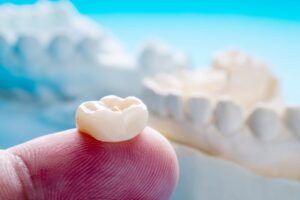
Dental crowns are one of the most common restorative treatments in dentistry today, helping patients restore damaged or decayed teeth with strong, natural-looking results. But the concept of covering a tooth to protect and restore it isn’t new — in fact, dental crowns have been around for thousands of years. The history of dental crowns is fascinating and shows just how far dental care has come.
Ancient Beginnings
The earliest known dental crowns date back over 4,000 years. Archaeological evidence from ancient civilizations such as the Etruscans (around 700 B.C.) shows that people were already experimenting with tooth replacement and protection. The Etruscans used gold to create crowns and even bridges, which were considered a sign of wealth and status in addition to being functional.
Gold remained a popular material for crowns for centuries because it was durable, malleable, and resistant to corrosion. However, these early crowns were often more about appearance and social prestige than about restoring full function.
Middle Ages and Early Modern Dentistry
During the Middle Ages, dental techniques were limited, and tooth extractions were more common than restorative treatments. However, the wealthy sometimes sought out primitive crown-like restorations. By the 18th and 19th centuries, dental science was advancing, and crowns became more functional.
The first porcelain tooth crowns were developed in the early 1800s. Dentists began experimenting with porcelain because it could be shaped and colored to resemble natural teeth, offering a more esthetic solution than gold. Porcelain crowns were typically fused to a metal base to provide extra strength, a technique that would remain popular for nearly two centuries.
The Rise of Porcelain-Fused-to-Metal (PFM) Crowns
By the mid-20th century, porcelain-fused-to-metal (PFM) crowns became the gold standard. These crowns combined the strength of a metal substructure with the natural appearance of porcelain on the outside. PFMs offered patients an affordable and durable way to restore their teeth, though the metal base sometimes created a dark line near the gumline over time.
Modern Ceramic and Zirconia Crowns
Today, dental technology has advanced to the point where all-ceramic and zirconia crowns are widely used. These crowns are incredibly strong, biocompatible, and highly esthetic, with no metal underneath to show through.
From the gold crowns of the Etruscans to today’s same-day ceramic restorations, dental crowns have evolved dramatically. What began as a status symbol has become a highly advanced treatment that restores function, protects teeth, and creates confident smiles.
About the Author
Dr. Kimberly Peters has been practicing dentistry for more than a decade! She earned her dental degree from the Augusta University Dental College of Georgia. Throughout her career, she has completed several hours of continuing education through the Hinman Dental Society and consistently works to expand her knowledge and skills to better serve our patients. If you have a damaged tooth that needs saving with a dental crown, don’t hesitate to reach out to us online or call (770) 922-1666.
